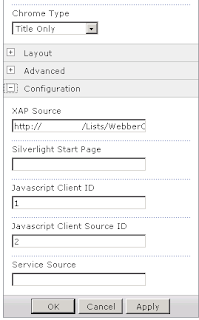SharePoint 2010 Silverlight Web Part JavaScript Bridge
Overview
This template contains base classes and scripts enabling Silverlight web parts (and ASP.Net web parts) to be created enabling client-side interaction with other Silverlight Web Parts. A JavaScript file is injected into the page automatically and allows Web Parts to register themselves for interaction with the bridge. If only Silverlight to Silverlight communication is required, local messaging could be used as an alternative mechanism, however this technique allows interaction from both Silverlight and ASP.Net web parts which is more flexible for SharePoint applications. A Web Part using the base classes has the following properties required for JS Bridge connection:
- JSClientID - Used to pass the JavaScript Bridge ClientID from the SharePoint UI to the Web Part. JSClientID is a simple identifier for components connecting to the JS Bridge.
- JSClientSourceID - Used to pass the JavaScript Bridge ClientSourceID from the SharePoint UI to the Web Part. JSClientSourceID indicates to the JS Bridge where a components connection is sourced.
- JSUniqueClientID - JSClientSourceID indicates to the JS Bridge the real ID of the component on the page. It is derived from the WebParts’s ClientID with an ‘SL’ suffix.
Registering Clients
When a JS Bridge Web Part loads, it registers itself with the JS Bridge using the registerClient method, this allows the bridge to locate the WebPart on the page and lets it know where to route data.
Installing
The package can be deployed straight to a local SharePoint 2010 server from Visual Studio 2010. The feature should appear in the default site collection features list:
Testing
To test the functionality, simply place 2 instances of the demo web part on a page. The demo web part is designed so one instance can talk to another instance of itself but normally different web parts would talk to each other.
The first web part can be configured as follows:
The second web part can be configured as follows:
Using the Silverlight UserControlBase Class
Obviously the contents of the base class can be copied to a user control, but to implement it as a base for a user control the following steps must be taken:
Application Manifest
The ‘ExternalCallersFromCrossDomain’ attribute must be set to ‘ScriptableOnly’ to allow applications hosted on a different site to the SharePoint site (cross-domain) to access the DOM; otherwise the JSBridge will not work. This can be a security risk particularly for public facing sites, so it's best to host the XAP in SharePoint.
<Deployment xmlns="http://schemas.microsoft.com/client/2007/deployment" xmlns:x="http://schemas.microsoft.com/winfx/2006/xaml" ExternalCallersFromCrossDomain="ScriptableOnly" > <Deployment.Parts> </Deployment.Parts> </Deployment> |
AssemblyInfo
The following attribute must be included in the AssemblyInfo file so that the UserControlBase can be implemented. The ‘System.Windows.Markup’ namespace needs referencing for this.
The following attribute must be included in the AssemblyInfo file so that the UserControlBase can be implemented. The ‘System.Windows.Markup’ namespace needs referencing for this.
[assembly: XmlnsDefinition("http://schemas.microsoft.com/winfx/2006/xaml/presentation", "WebberCross.JavaScriptBridge.SilverlightApplication11")] |
Calling JSBridgeSend
The example shows how an object can easily be JSON serialized then sent to the JS Bridge where it will be multi-cast to all registered web parts with a matching JavaScriptClintSourceID
// Send a message to the bridge DemoMessage msg = new DemoMessage("Hello from Silverlight Application", base._jsClientID.ToString()); string jsonMsg = JSONHelper.Serialize(msg); base.JSBridgeSend(jsonMsg); |
Overriding JSBridgeReceive
The example shows how to override the 'JSBridgeReceive' method to deserialize the sent object:
// Override base JSBridgeReceive method public override void JSBridgeReceive(string arg) { try { // Deserialize message DemoMessage msg = JSONHelper.Deserialize<DemoMessage>(arg); // Write message to label this.lbl3.Text = string.Format("{0}, from JSBridge Client {1}", msg.Message, msg.JSClientID); } catch (Exception ex) { MessageBox.Show(ex.ToString()); } } |
Conclusion
The JavaScript Bridge is a great way of enabling Silverlight web parts to interact with each other in the browser, it also allows Silverlight web parts to be communicated with from a web page. The base classes provide a quick way of getting standard behavior in sets of web parts.













